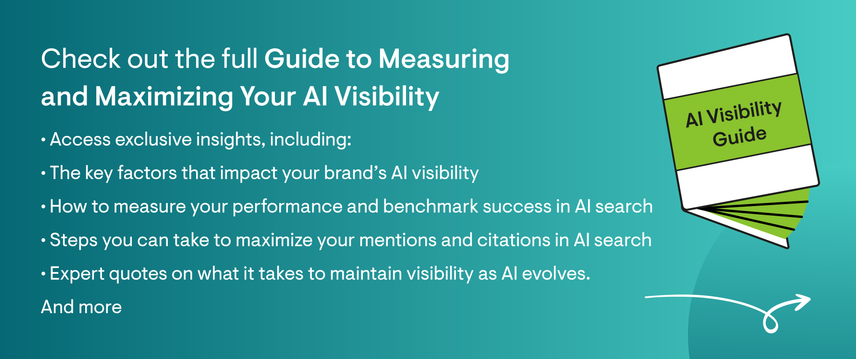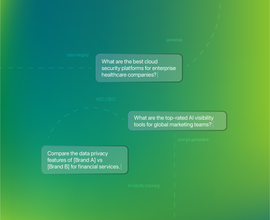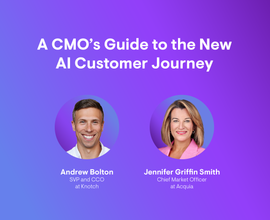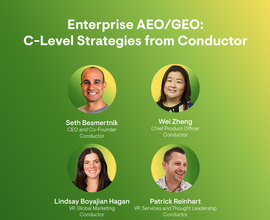How to Measure and Maximize Your AI Visibility
Growing AI visibility is a continuous process geared towards optimizing your content and brand authority to be mentioned and cited in answers from large language models (LLMs) and other AI search experiences. From high-quality, authoritative content to accessibility and structured data, several key factors determine whether AI models, like ChatGPT, Claude, and Gemini, trust and reference your brand as a definitive source.
Dive into strategies to measure your presence, optimize for mentions and citations, and ensure your brand thrives in the new era of AI-driven search.
I’m going to assume you’ve heard this in some form by now, but AI is changing the digital landscape as we know it. An industry that used to run on Google’s 10 blue links is now rapidly transitioning to digital experiences based on personalized prompts and direct answers from AI.
Success isn’t about rankings, keywords, and organic traffic anymore. To drive success, brands need to prioritize visibility across all search experiences and optimize with the goal of improving mentions and citations within AI responses.
Which begs the question: How do brands measure and maximize their visibility in AI? Dive into our AI Visibility guide to understand the key factors that impact your AI visibility, steps to take to help you maximize it, and how to monitor your presence over the long haul.
What is AI visibility?
AI visibility refers to how often and effectively your brand, products, or content appear in AI search and large language models (LLMs). This includes search experiences like Google AI Overviews, ChatGPT , Perplexity , AI Mode, and other answer engines that synthesize information and provide direct answers to a user’s question, often citing their sources.
Here’s a look at an AI Overview result in Google.
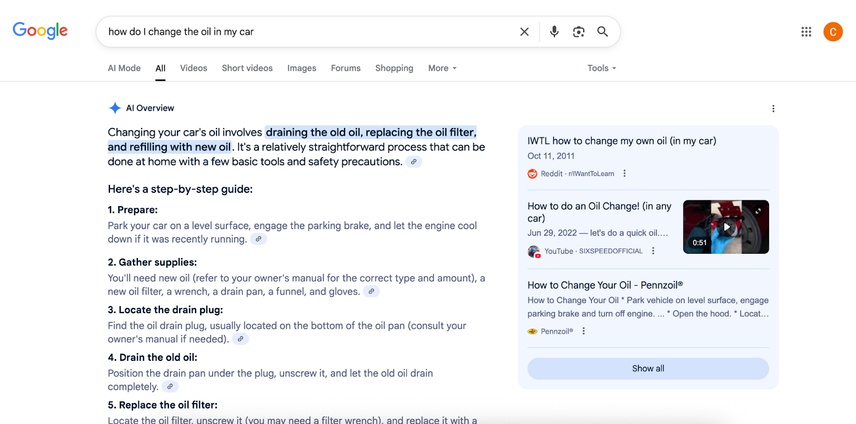
Here we have a shot of a search and cited sources in Perplexity.
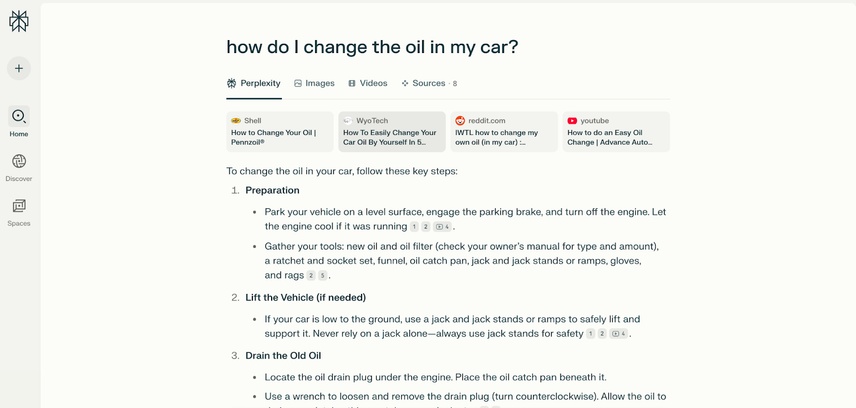
Below is a shot of the same query in ChatGPT.
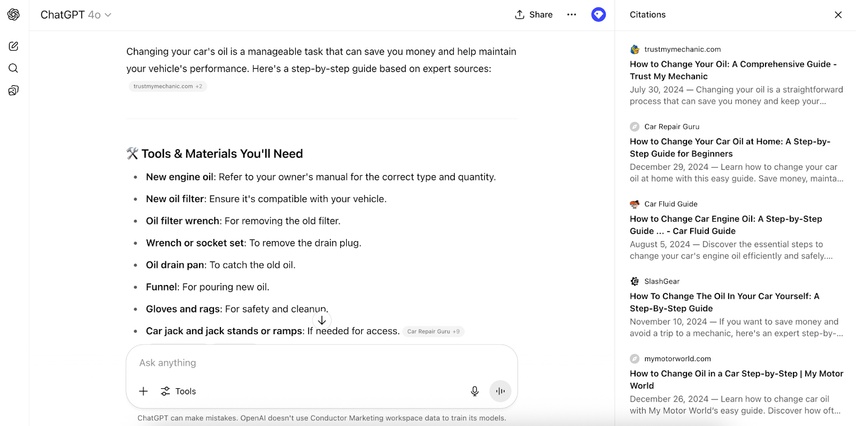
Finally, here we have Google’s AI ModeAI Mode
AI mode is a search feature using AI to provide comprehensive answers by synthesizing information from multiple sources into direct responses.
Learn more.
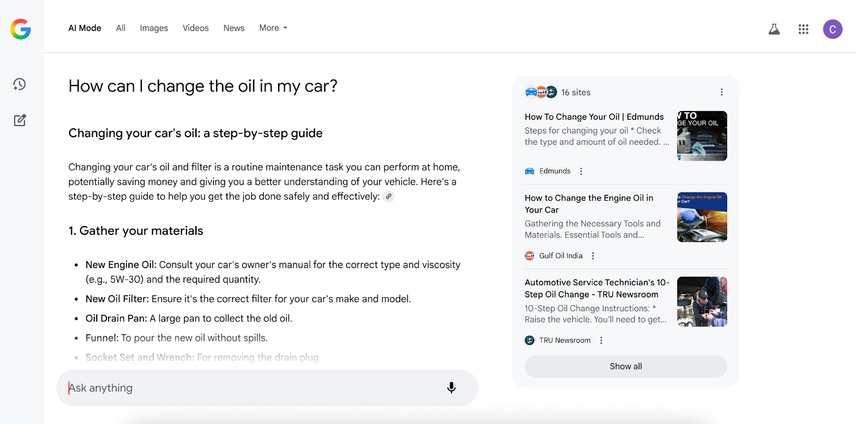
These AI models process billions of data points, drawing from brand websites, academic papers, news articles, and other online content to generate comprehensive, conversational responses tailored to a user's specific query.
When your content or brand is mentioned or cited by AI, that impacts your AI visibility. As you probably noticed, this represents a significant shift from traditional search engine results pages (SERPs), where the goal was primarily to rank high on a list of links. Now, the emphasis is on being the definitive, authoritative source that an AI selects and references.
What makes AI visibility different from traditional search visibility?
Optimizing for AI search is fundamentally different from optimizing for traditional keywordKeyword
A keyword is what users write into a search engine when they want to find something specific.
Learn more ranking. While traditional search engines focus on matching keywords to web pages and ranking them based on relevance and authority, AI models prioritize factual accuracy, direct answers, and contextual relevance.
The goal of AI search is to directly answer a user's question. With their question answered, that user is much less likely to follow a link to your website, so metrics like organic traffic don’t carry the same weight that they used to. Despite that, a strong presence in AI responses can dramatically increase brand awareness and topical authorityTopical Authority
Topical authority is the expertise and credibility a website demonstrates on a subject through comprehensive, interconnected, high-quality content.
Learn more, even in a "zero-click" search environment.
Why is AI visibility important?
AI visibility is important because traditional search is getting less important. The reduced popularity of traditional search engines means that if your brand isn’t visible within AI-generated responses, a growing portion of your target audience will have no idea you exist.
AI visibility is not just about adapting to new technology; it’s about maintaining and expanding your brand’s presence in the digital ecosystem. Brands that prioritize AI visibility will:
- Establish expertise and topical authority: Position your brand as an expert source that AI models trust and cite. This is a great way to improve brand awareness and how both AI and audiences view your content.
- Increase brand awareness: Getting your brand mentioned directly in AI responses, putting it front and center for users. This leads to an increased likelihood of having your brand mentioned or cited by AI.
- Influence purchasing decisions: AI responses can influence opinions and direct users toward specific brands or solutions, even without a direct click.
- Drive high-quality intent-driven traffic: While direct website traffic may fall thanks to AI search, those users who do visit your site are more likely to convert than much of the organic traffic search engines drive. Think about how users can ask ChatGPT and other answer engines to show their sources for a response. For example, imagine someone asking an answer engine to show them affordable lights for a studio apartment and provide product links. That delivers high-quality traffic that’s ready to convert when they click one of the links. Plus, AI citations and mentions establish your authority, which can lead to future searches for your brand or direct website visits.
Ultimately, adapting to this shift towards AI is imperative for your brand’s growth.
Key factors that impact your AI visibility
Let’s make it clear upfront that nobody knows for sure every factor that impacts how LLMs and AI crawl your site and generate responses. It’s similar to SEO in that way, where we know some factors that impact performance, but not all of them.
That said, there is plenty you can do to put your content in the best position to drive mentions and citations in AI search. Here are some of the key factors that influence AI visibility:
- Content quality and authority: AI models favor high-quality, comprehensive, and factually accurate content. The better the content, the more likely it is that it will be mentioned or cited.
- Authorship & expertise: AI models, like search engines, look for signals of Experience, Expertise, Authoritativeness, and Trustworthiness (E-E-A-T) . Brands with a strong reputation for expertise in their field are more likely to be cited by AI.
- User intent and content relevance: Keywords aren’t enough anymore. AI models are designed to understand complex queries on a topical level and provide highly relevant responses. That means your content should anticipate user questions and offer clear, concise solutions. That means prioritizing your content’s topical authority. Your site’s topical and domain authority refer to how well your site covers a topic holistically, by understanding user need, and providing content that answers all of their questions.
- Brand mentions and citation velocity: Just like how backlinks signal authority in traditional SEO, brand mentions and citations from other sources are critical for AI visibility. When reputable sources mention your brand or link to your content, it’s essentially a vote of confidence in your brand that AI models recognize.
- User experience: While not a direct factor for AI visibility, a strong user experience (UX) can indirectly impact it. Just like with SEO, a positive UX can contribute to your overall site authority, which AI models may consider when evaluating sources.
- Content structure: AI models can more easily parse and understand well-structured content. This includes using clear headings and subheadings, bulleted or numbered lists, tables, and definitional content. Well-structured content also provides a better user experience, helping to boost your authority amongst your audience.
- LLM accessibility: For LLMs to use your content effectively, it must be easily accessible and understandable by machines. This means ensuring your website's technical foundation is solid and taking steps like leveraging Schema markup.

How to measure your AI visibility?
AI search is making traditional SEO metrics less predictive of success. That makes it all the more important for brands to understand how they’re appearing in AI search so they can take steps to optimize their presence.
Understanding and tracking your AI presence
Tracking AI presence involves monitoring how your brand and content are referenced in AI-generated answers. New metrics that brands need to focus on are mentions and citations within AI responses. These metrics help you understand if AI models consider your content a primary, trusted source for specific queries, or if you have opportunities to optimize.
Unlike with traditional SEO, where smaller websites or organizations could get away with manual tracking, AEO accounts for an infinite number of prompts for every possible intent scenario combined with login states that show personalized outputs; this results in endless generated responses. Getting the full picture of your AI search visibility requires an automated and intelligent end-to-end AEO tool, like Conductor, that is capable of analyzing this data at scale.
AI visibility measurement tool examples
AI visibility tools allow you to measure and understand your presence in AI search at speed and scale, making them essential for brands both large and small. The most impactful AI visibility tools or platforms should have some, and preferably all, of the following capabilities:
- Comprehensive AI engine coverage (ChatGPT, Perplexity, AI Overviews)
- Real-time monitoring
- Actionable insights
- Integration capabilities
- Enterprise features
- Attribution modeling and traffic impact
- Historical trend analysis
- Competitor and market benchmarking
- Content readiness scoring
- Custom query and entity tracking

Dive deep into the factors that make a strong AI visibility platform and learn how to evaluate different solutions with our Guide to AI Visibility Platforms.
Several tools and platforms are now available to measure and maximize AI visibility for small and enterprise-level companies. Below are some details about a few of the top players in the space, but be sure to dive deep into each platform and tool's capabilities to see which one best meets your specific organizational needs.
Athena
Athena is concerned with monitoring your brand’s reputation. What sets Athena apart from the pack is its advanced sentiment analysis and crisis management features, which help teams proactively address negative mentions before they impact engagement and conversions. It’s ideal for larger organizations focused on protecting their brand's reputation across AI search.
Conductor
Conductor is the only end-to-end solution that supports AEO/GEO/SEO from opportunity and content generation to measurement and monitoring. Conductor is powered by a proprietary data platform, unifying intent signals from AI and traditional search engines, analytics, impressions, and technical health signals alongside API-based AI visibility technology to help users increase brand visibility, traffic, and conversions across large language models (LLMs) and other digital experiences.
Conductor shows you exactly where your brand appears in AI-generated answers on platforms like ChatGPT and Perplexity, while also giving insight into how you’re performing against competitors for AI visibility.
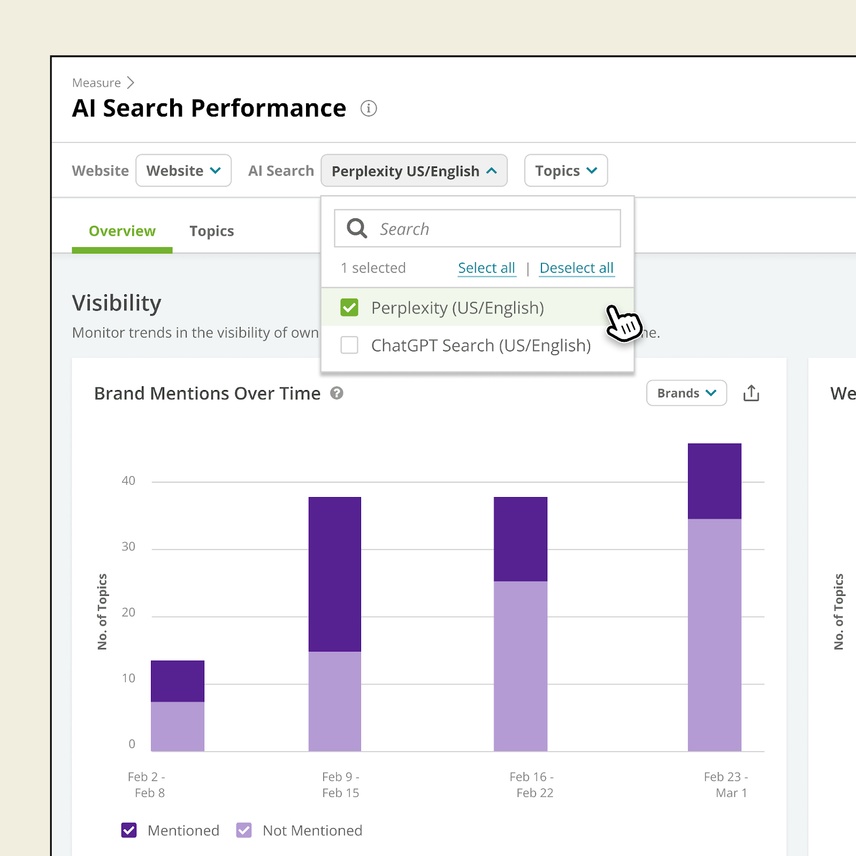
It helps pinpoint the best opportunities to create and optimize content to maximize visibility and authority across every search surface. Then, real-time monitoring and alerting provides a 24/7 insurance policy to ensure LLMs are finding and indexing your content for peak performance.
Geneo
Geneo keeps things straightforward. It provides solid AI visibility tracking, but without the advanced features and deeper insights that larger organizations may need. Geneo is great for teams getting started with AI visibility, as it provides what you need to understand your AI presence and track competitive positioning while not paying for features that small teams may never use, but enterprise orgs likely can’t live without.
Peec AI
Peec AI is similar to Geneo, a user-friendly solution that is generally easy for folks to learn quickly. It tracks brand mentions across AI engines with simplified reporting that surfaces your most important needs and opportunities to improve. Compatible with answer engines like ChatGPT, Perplexity, Google AI Overviews, and other major AI search engines, Peec is known for a small learning curve, but its limited scope likely won’t provide enough insight for enterprise-level organizations.
Profound AI
Profound AI focuses on helping businesses monitor, measure, and enhance their brand's presence within generative AIGenerative AI
Generative AI is a class of AI that creates content like text, images, and code rather than analyzing existing data, powering tools like AI search.
Learn more outputs from platforms like ChatGPT, Claude, and Google's AI Overviews. Geared towards enterprise-level businesses.
Rankscale
Rankscale is different from smaller solutions like Peec AI and Geneo. Rankscale shows you how AI visibility fits into your bigger marketing picture with features like competitor benchmarking, citation analysis, and sentiment analysis. It helps you understand how AI visibility connects to your other digital marketing efforts and business outcomes. This integrated view can be really valuable if you're trying to understand the broader impact AI search is having on your performance.
ScrunchAI
ScrunchAI helps businesses monitor, optimize, and improve how they appear in AI-generated search results by focusing on brand narrative and accuracy. Good for teams that are highly focused on their brand's narrative and tone in AI-generated answers.
Interpreting your AI visibility
When assessing your AI visibility, look for more than just a mention. Pay attention to whether your content is directly cited, if its core message is accurately summarized, and if the sentiment of the mention is favorable. High-quality, accurate citations indicate that AI models perceive your brand as a reliable and authoritative source. This interpretation helps refine your content strategy.
Steps to improve your AI visibility
Improving your AI visibility is an ongoing process for optimizing your content and technical foundation to align with how AI models process information. Just like with SEO, this is not a process that is one and done; there will always be opportunities to further optimize your content for AI visibility.
Content strategies to improve AI visibility
Just like with SEO, the quality of your content has a significant impact on how users and answer engines view your site. The following content strategies are key to maximizing your AI visibility.
- Highlight your unique expertise in specific and authoritative content
- Prioritize satisfying user intent
- Structure your content for machine-reading
- Leverage a human-in-the-loop approach when creating content
- Expand digital PR
Technical strategies to improve AI visibility
If your website isn’t technically sound, users won’t want to visit, and answer engines won’t surface it. The following technical website strategies are key to improving your user experienceUser Experience
User experience (or UX for short) is a term used to describe the experience a user has with a product.
Learn more and AI visibility.
- Leverage Schema
- Monitor your website for technical issues
- Improve your site’s UX
- Prioritize LLM accessibility
AI visibility in review
AI visibility is not a fleeting trend; it’s here to stay. As AI models become more integrated into daily search behaviors, proactive answer engine optimization (AEO) strategies will be essential for maintaining and growing your brand's presence.
The focus is shifting from merely optimizing for traditional search engineSearch Engine
A search engine is a website through which users can search internet content.
Learn more algorithms to understanding and influencing how large language models interpret information from your site. Brands that make informed, strategic decisions now to invest in AI visibility will that continue to drive growth and lead their industries into this exciting new era of search.
